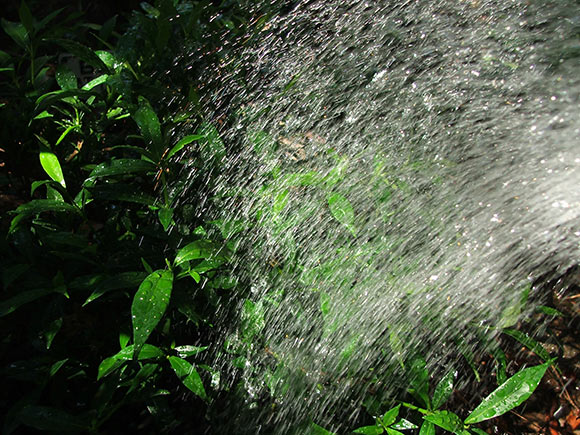Dear clients and Friends,
I never did get around to a Spring newsletter this year--the season came on suddenly, and with a bang, and it’s been that way ever since, until just this week. After last Winter’s brutal weather, and the subsequent very late Spring, I’ve wanted this Summer to last and last and last. It feels like we are at the pinnacle right now--balanced between the seasons--before the downswing towards Fall. I hope you are savoring every minute of the lovely Summer we are enjoying.
Don’t Forget to Water!
After all the rain we’ve had this Spring and early Summer, it seems impossible that we’d even need to talk about watering--yet here we are. Right on schedule, we are drying out again, and it will likely remain this way until late September or early October, unless we have a hurricane (let’s hope not).
If you have new shrubs and trees that were installed within the last year or two, and you have a sprinkler system, don’t depend on the sprinkler system to do a proper job of watering your newer plants. Irrigation systems are great for established gardens, lawns, and shallow-rooted plants, but you’ve got to deep-soak your new things, especially when the temperatures are above 90F and we haven’t had rain for awhile. Here are some further notes:
When plants are rooted and growing leaves, they are taking up water from the ground. It's like suction (and much like our sweating): the leaves "sweat", and in the process, pull the water from the ground with the roots, up through the plant, and out through the leaves. This is called transpiration. The hotter, drier, and sunnier, the faster the transpiration, thus the increased water need. It's like a continuous loop of water drawn in and sweated out. When the days shorten in the Fall, deciduous plants anticipate the coming cold weather, drop their leaves, and go dormant. Evergreens just go dormant, of course--all plants just stop from the ground up. The roots will continue to grow until the ground gets below 40 degrees. This is all very simplistic, of course--so much more is going on, but you get the drift.
Things are different when a plant is first planted. That's because it takes time to root--in other words, the little feeder roots that take up the water have not yet come from the rootball of the transplanted plant and established themselves into the surrounding soil. So we have to baby it for a few weeks until this happens. Too little water, and the plant often drops its yellow or brown (dried) leaves as a defense mechanism because it is trying to conserve water in its stems; when water is available, again, it has the strength saved up to leaf out again. Conversely, when too much water is around the roots and the rootball cannot get any oxygen (because this is important, too), the plant holds its wilted, often browning (and they appear water-soaked), leaves because it doesn't need any water and the systems shut down. Both of these scenarios can happen after plants are just put in--there is a fine balance. Believe it or not, more plants die of overwatering than under watering. Isn't that crazy? But it's true.
As the days shorten, and the sun becomes less intense as we move towards Fall, your plants will require less and less water--you can probably cut the frequency a bit. Likewise, plants dry out more quickly when the humidity is low; less quickly when the humidity is high. Monitor carefully so you don’t over- or under-water.
Get to know your garden and its “hot spots”--places that dry more quickly than others. This is true even if you have an irrigation system. Put your fingers under the mulch, into the soil, and check for moisture. Don’t depend on a quick thunderstorm to water for you--deep soak your garden as needed. You can let the lawn go dormant--it will usually green up again, once the rains return--or provide once inch of water per week to keep it green. If hand-watering your plants, take the nozzle off the hose, and aim that nice, steady stream of water directly at the center of the plant where it meets the soil. Let the water soak in deeply. When using sprinklers, rain gauges are a big help--or (better) check the soil with your fingers. And remember: like winter-damaged plants, those left unwatered are not guaranteed--another incentive to get out the hose!
Weeds. Ugh. I know, I know--it’s too hot, too dry, there are too many--etc. etc. Really, though, you must get to them before they go to seed or you are really going to have your work cut out for you. At the very least, go out and cut off those seedheads before they ripen and fall!
I find that the best time to pull weeds is after a good rain or just after I’ve watered. The weeds slip right out of the ground, for the most part, except for a few stubborn ones; then, I have to get out the pointed trowel (a wonderful tool) or a dandelion weeder.
After you weed, you can put down some mulch to cover the bare ground--it helps to control weeds and helps keep the soil from drying out so quickly.
Pruning. All major pruning should be complete for the season. Spring-flowering plants (dogwoods, azaleas, rhododendrons, forsythia, camellias, macrophylla hydrangeas (the blue/pink ones), etc.) are already setting buds for next year. These bloom off the previous year’s growth. Pruning now will cut off the buds. Wait until next Spring, just after they bloom, to prune.
Summer bloomers are blooming now or getting ready to bloom. These bloom off new growth. Wait until next Spring to prune these.
Major pruning of evergreens now will encourage new growth, which might not harden off in time to withstand Winter freezes.
Slight clipping here and there does no harm.
Next Story: Saying Goodbye to My Old Oak Tree >

